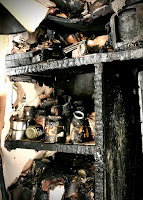I was recently introduced to someone at a family gathering, and the person said, "Oh, you're the writer." I was taken back and confessed that I was honored by her statement. In all my life, I don't think I've ever heard those four words. I smiled and nodded but she read the pause behind my eyes and added, "I mean you wrote about the fire. That was beautiful."
"Yes, yes... that is me." It was much easier to answer to her follow up, but I was no less honored by her words. The fact that I am telling you this confirms just how encouraging it was to hear from a stranger. But stranger still is the thought that something so tragic could possibly be presented to show
beauty in the ashes. This post may test that premise.
.[Click on photos to enlarge.]
*************
We had traveled the three-and-a-half hours from west Michigan to the east side of the state for a family reunion. Just a few moments before the kind words of that introduction, I was at the house, or rather the ruins of the house, with my brother-in-law Jack.
It was the first time I had been there for over two years. For six weeks, I had seen only the pictures that I've shared here. All my siblings live in the Macomb or Oakland County, and they had each been at the site the night of or the morning after the fire. I could not come until now, and being the one sibling who had not been there felt a bit like missing a funeral. In a similar sense, I thought stopping by would help bring some closure.
My family and I spent the night at Kathy and Jack's temporary home the night before. One carload went ahead to the gathering, and Jack and I went in his car so we could stop by the house.
As we pulled in the snow-covered driveway, I said, "I know it may seem strange that I am asking you to do this, but I really wanted to come here in person."
"Nope. Not strange at all," Jack said," I come by every day. I've gotten to where it feels normal."

We walked through the scorched hedges that line the walk to the front porch, stepped over the security fence, and just started roaming around at our own pace, stepping over fallen chimney bricks, timbers, and black debris.

My eyes kept squinting toward details, as if they had "facial recognition" software and the ability to zoom in on twisted skeletal steel frames and other unrecognizable forms in the blackened ruins.
Like a grim version of the "
I Spy" picture books my daughters and I used to search at bedtime. Each page had dozens of objects hidden in plain sight.
[These past two pictures show a doll crib by sister got for Christmas about 65 years ago.]
It was several minutes before either Jack or I spoke, and I simply said, "I'm glad you are past the shock of this, but I'm warning you, I could just bawl." I swallowed hard, but kept methodically pacing and peering into the sad mess.
Then I began taking pictures of the things my eyes had sorted out, and in an odd, inexplicable way there was a strange sort of beauty in each discovery. Seeing a type of art in the ruins removed emotion from reality in the same way that archaeologist find beauty in the stones of
Rome or
Pompeii or
Aztec digs.
I walked the full circle around the ruins and sometimes poked my head into thresholds and openings in the walls. I never fully crossed to the "inside space." It felt unsafe but something more... it felt sanctified, set apart. It was no longer a place for living.
As I stood in the outside kitchen door, I remembered how it used to be as if it had not been lost to fire but instead to passing time like an abandoned "
Woodpile" in the woods:
"And this is how we lived," I thought. "This is how we built our homes, and 'feathered our nests,' and bought and stored and cooked our food, and sat to meals and went to bed and shared our lives together. This is how man set the stage upon which life was played."

The thoughts seemed spoken as if by some omniscient sage looking back from a future time when things as they were might seem an ancient past.

I stepped around the corner to where my walk had started. Jack had gone to close the garage which left me there on the front porch alone.
Stepping to but not through the threshold, I noticed to my left the burnt garland of evergreen boughs dangling from the porch light.
I touched the brittle string of melted Christmas lights. I'd forgotten the fire had happened just
three days after Christmas. It felt like an eternity ago.
Just beyond the door frame was another frame of what had been the coat closet door. Nothing hung inside. There between the closet and the stairs, for years and years, was the scene of our legendary long good-byes. Coats were handed out as stocking feet sorted and stepped into shoes that had been slipped off in the corner of the floor. I could now see through the floor to the basement.
It was then my eyes and nose began dripping, and I hoped Jack couldn't see.

"Ready to go?" he asked, now waiting by the car.
"Yes." I said without showing my face. I blew my nose and wiped my eyes then turned toward him. Stepping from the porch, I smiled a smile I hoped worked from a distance.
It didn't. I plopped in the seat and closed the door with thud.
Jack started the car. "It's okay, Tom. I get it. Sometimes I just come here and stare... and think... and stare some more."
I have not yet seen the plans for the home Kathy and Jack will rebuild, but there are plans. A rebuilding process is beginning where it matters most. They know God has a plan; they know He chose to try by fire; they know much chaff has burned away and,
up from the ashes, there is love among the ruins that endures to begin anew.
*************
Robert Browning's poem "
Love Among The Ruins" tells the tale of a glorious ancient city that is now reduced to a single standing pillar, but at that pillar the poet's love waits to meet him. It is not my favorite poem, but it has a great title. Browning's somewhat strained lines say in so many words, "Glorious as past realities might be, after all is said and done, only love endures." Having stood there on the ruins of my sister's porch and looking through the walls to days gone by, that much I know is true.
(Demolition begins this week.)
A recently exposed dresser (contents may be salvageable).
The roll-top desk where some documents survived.
The Amish-made timbers of the breezeway.
From the porch, as you look through the fireplace and living room,
you see the home behind the home
where the story behind this story took place from 1968 to
2008.





























